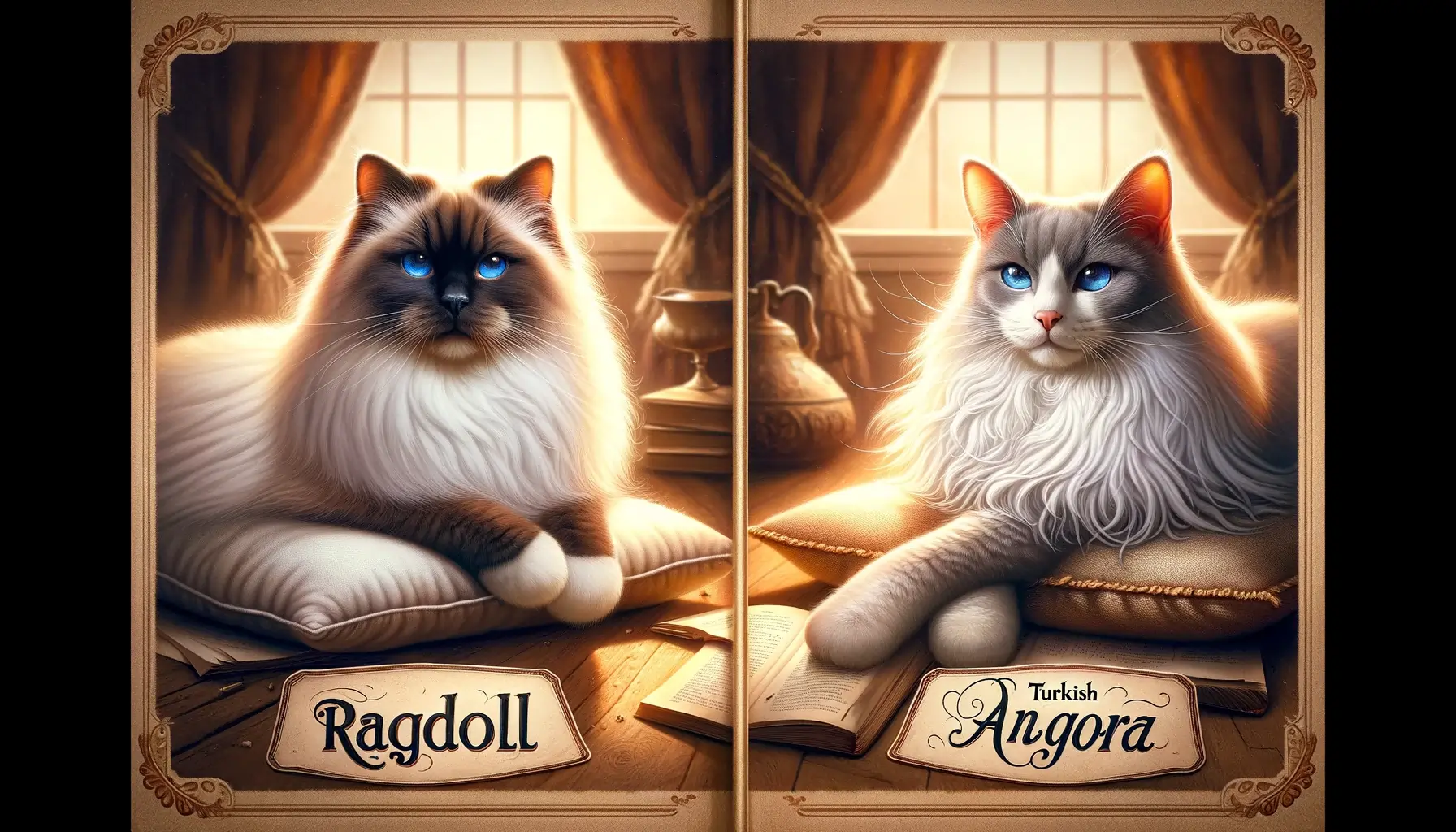Ragdoll cats are big, tender, and loving pets. Blue eyes and a soft, long coat captivate immediate attention. Turkish Angora cats are medium-sized, playful, and smart animals.
Their length of hair is medium long; it’s often white, though the eye color can be different. Do you want to know the disparity between Ragdoll and Turkish Angora cats? This text will show you some special traits that each of them has, traits that are likely to shock you. Let us narrow down to each cat’s physical features and behavior.
Decide which animal will be your best friend. Do this by comparing its activity levels to the environment it lives in. now. Let’s see. “Turkish Angoras have a beautiful coat. It is often pure white. People know Ragdolls for their loving personalities.”
Visual Differences
| Characteristic | Ragdoll | Turkish Angora |
|---|---|---|
| Origin | United States | Turkey |
| Coat | Long, semi-long | Semi-long |
| Pattern | Colorpoint, mitted, bicolor | All colors and patterns |
| Body type | Cobby | Semi-cobby |
| Weight | 10-20 lbs | 6-12 lbs |
| Personality | Gentle, friendly, calm | Playful, active, intelligent |
| Eye color | Blue, aqua, green | Blue, green, amber |
| Lifespan | 12-17 years | 12-18 years |
What is Ragdoll Cat
Ragdoll cats are a large, color-pointed breed with a distinct coat and blue eyes, originating in California in the 1960s by breeder Ann Baker. They are known for their laid-back personalities, semi-long coats, and a tendency to go floppy when picked up, hence the name “Ragdoll”. Ragdolls are friendly, social, and affectionate, making them great for families and individuals alike.
They require regular grooming and can be prone to health issues such as heart disease and eye and ear care. Ragdolls live for a long time and are not hypoallergenic. Their size requires a larger living space, and they are not good hunters, so they should be kept indoors. Ragdolls come in four main patterns and six major colors, with all kittens being born completely white
What is Turkish Angora Cat
The Turkish Angora is an ancient breed of cat that originated in Turkey, with records dating back to the 16th century. They were brought to Europe in the 17th century and quickly became popular due to their striking appearance and friendly personalities. The breed was brought to the United States in the 1960s and was recognized by the Cat Fanciers’ Association in 1973. Today, Turkish Angoras are known for their long, silky coats, slender bodies, and striking blue eyes.
They are intelligent, active, and playful, and they make great companions for people who want a lively and engaging pet. Despite their delicate appearance, Turkish Angoras are hardy and healthy, and they are relatively low-maintenance in terms of grooming. They are a treasured breed in their native country and are beloved worldwide for their unique beauty and charming personalities.
Physical Characteristics
Ragdoll cats have a heavy build, and they are large and muscular as well. There is a semi-longhaired coat in various color points, such as seal, blue, and lilac. They always have blue eyes that mark their look.
Turkish Angora cats have medium-sized bodies. Its shape is like a slender column, and it contains thin bones. Most often, they have medium hair of white color; but, coats may have different colors. Blue, green, amber, or even odd-eye colors, where one can be of a different color.
Size and Build
Ragdoll cats have a weight range of 10 to 20 pounds. They are large with a muscular, heavy-boned build that gives them a robust appearance. This is because their long, sturdy bodies make them look powerful yet gentle.
The Turkish Angora cat has a medium build, weighing 5-10 pounds. People know them for their slim and delicate bone structure. They look as if they were graceful creatures. Their bodies are swift and frail imitations. They are ideal for the active games of their playful behavior.
Coat and Color
The Ragdoll cat has a semi-longhaired coat. It is smooth and silky, and it comes in different color points, such as seal, blue, chocolate, or lilac. They have a light coat on most of their body, but dark parts on their ears, face, paws, or tail.
Turkish Angoras have medium-long fur. It is shiny and fine. Most of them are white, but some come in other colors such as black, blue, and red. This is because their hairs are prone to tangles and mats. This makes them easier to care for.
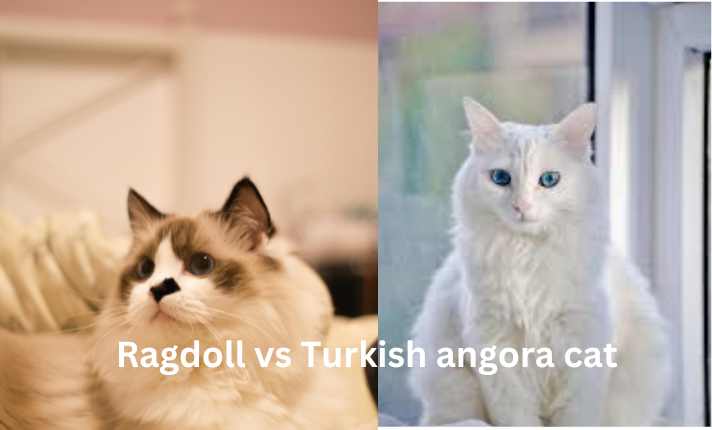
Personality and Temperament
Ragdoll cats are easygoing. They love humans and other pets. They are often carried without any resistance. That is why they are called Ragdolls. They are friendly. They form good relationships with children and other pets.
Turkish Angora cats are always running, bouncing, and thinking sharply. They might look reserved, but they are always ready to interact with human beings. Their exploratory nature is due to their inquisitiveness.
Ragdoll and Turkish Angora cat: Grooming Requirement
Ragdolls and Turkish Angoras are both beautiful and elegant breeds, but they have different grooming requirements due to their distinct coat types.
Ragdolls, known for their semi-long, plush coats, have lower maintenance grooming needs compared to Turkish Angoras. Their fur is relatively easy to manage, with occasional grooming recommended to prevent matting and tangles. A slicker brush or comb can be used once or twice a week to maintain the coat’s shine and remove loose hair. Ragdolls also shed seasonally, so grooming frequency might increase during these periods.
On the other hand, Turkish Angoras have long, silky coats that require more attention to keep them in good condition. Their fine and delicate fur is prone to matting and tangling, making regular grooming essential. Aim to brush their coat daily or at least every other day with a soft-bristle brush or comb to remove loose hair and prevent mats. Turkish Angoras also benefit from additional grooming, such as nail trimming, teeth brushing, and ear and eye checks, to maintain their overall health.
Both breeds are beautiful and require some level of grooming, Turkish Angoras demand more frequent and thorough care due to their fine and silky coats. Ragdolls have lower maintenance needs, making them a more suitable choice for those with limited grooming time.
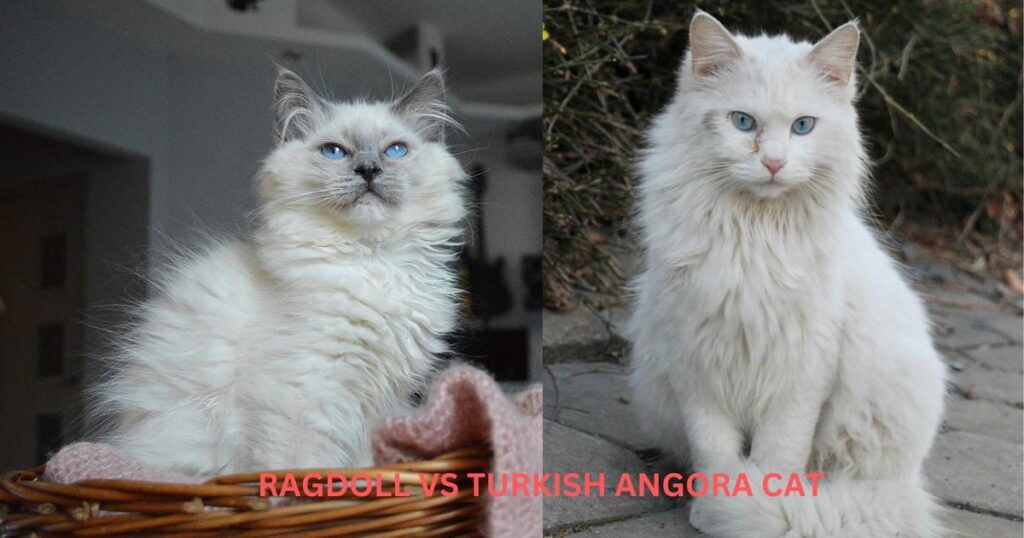
Vocalness:
Ragdoll and Turkish Angora cats have different personalities when it comes to vocalness. The Ragdoll is known for its exceptionally sweet nature and quiet purring, and they are not particularly talkative.
On the other hand, Turkish Angoras are much more vocal than Ragdolls and often “talk” quite a bit with their owners, using meows, trills, or chirps to express their feelings or demand attention. This difference in vocalness is one of the factors that distinguish these two popular breeds of domestic cats.
Ragdoll And Turkish Angora Are Good With Children And Other Pets
When it comes to compatibility with children and other pets, both Ragdoll and Turkish Angora cats are known for their affectionate and playful personalities. They can be good with children who are gentle and respectful. Ragdolls are often described as docile and relaxed, making them tolerant and gentle around unfamiliar animals or people.
On the other hand, Turkish Angoras are more active and energetic, with a strong muscle structure that allows them to be agile and playful. While not as affectionate as Ragdolls, Turkish Angoras are known to be quite vocal and expressive, often engaging in meows, trills, or chirps to communicate with their owners and demand attention.
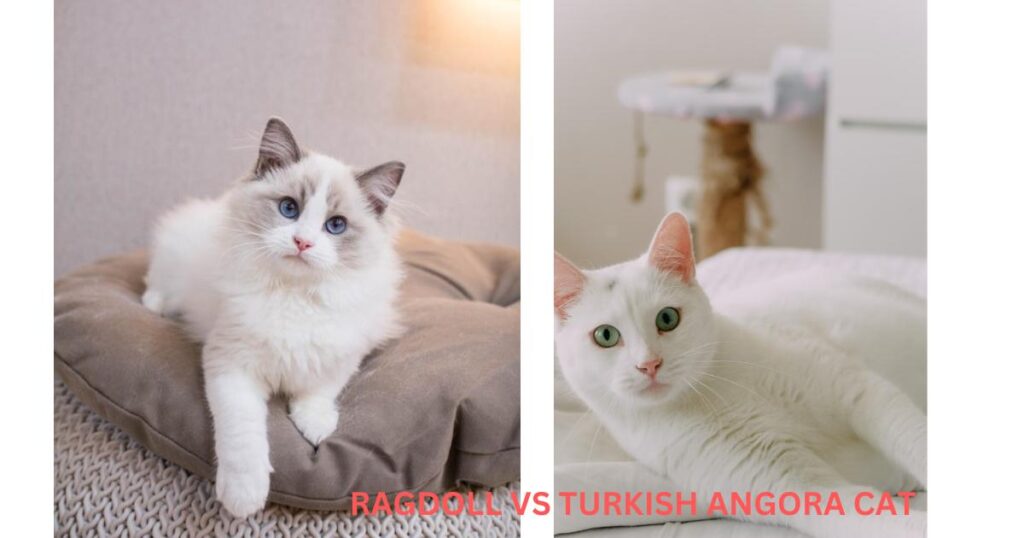
Ragdoll vs Turkish Angora cat health concerns
Ragdoll and Turkish Angora cats are generally healthy breeds, but they can have some health issues. Ragdolls are prone to Hypertrophic Cardiomyopathy (HCM) and Feline Infectious Peritonitis (FIP). Turkish Angoras, on the other hand, may suffer from deafness, especially in white Angoras with one or two blue eyes. They may also develop Hypertrophic Cardiomyopathy (HCM), Ataxia, Chronic Kidney Disease (CKD), and dental problems. Proper dental hygiene, regular check-ups by a veterinarian, and a healthy lifestyle can help prevent or manage these health issues in both breeds.
In terms of minor health issues, Ragdolls may require occasional grooming to keep their coat in good condition, while Turkish Angoras may be prone to hairballs due to excessive grooming and licking. Both breeds may benefit from regular dental care and weekly ear checks to maintain their overall health.
Ragdoll Vs Turkish Angora: Cost
Ragdolls and Turkish Angoras are both expensive breeds of cats to purchase, with kittens costing anywhere between $1000 – $4000 for a Ragdoll and $650 to $2000 for a Turkish Angora. This price difference depends on factors such as lineage, location of the breeder, and color/pattern of coat. It’s important to note that the cost of owning a cat goes beyond the initial purchase price, as regular veterinary care, food, and other supplies are necessary to ensure the cat’s health and well-being.
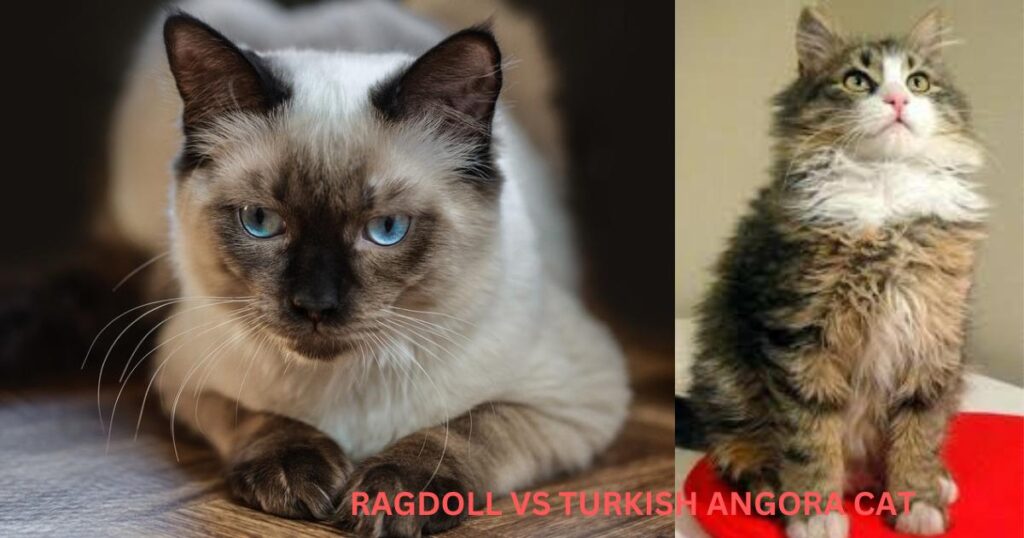
Conclusion
Ragdolls and Turkish Angoras are both attractive breeds of domestic cats, each with their own unique personalities and physical appearance. When considering adopting one of these breeds, it’s important to take into account their temperament, intelligence, vocalness, and physical appearance to ensure a good fit for your lifestyle and preferences. Both breeds can be compatible with children and other pets, but socialization is important to ensure a harmonious relationship.
Whether you’re looking for a relaxed and affectionate companion or an active and energetic playmate, Ragdolls and Turkish Angoras both have their own unique qualities that make them special.

Hey guys, My name is Simon Smith. I’m from Canada and live near Victoria
I live with my sweet family and have 20+ Ragdolls of different types. I love them as my own children. My profession is as a hotel manager.
I love to keep Ragdolls and grow their breeder case. I have 7 years of experience.
I’m an expert in cat care. So, I’m here to provide you with new information about my cats daily. This is my personal blog website, so I request that you kindly visit our site daily.
If you’re a Ragdolls lover and you have any questions or confusion about cats, text me on the Contact Us page or Gmail.
Thank u
